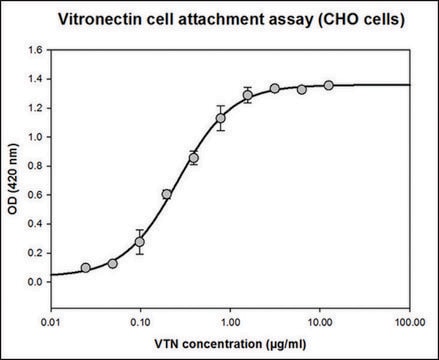Kluczowe dokumenty
ECM001
Human Fibronectin
recombinant, expressed in HEK 293 cells, powder, suitable for cell culture
Synonim(y):
Fibronectin, CIG, Cold-insoluble globulin, FN
About This Item
Polecane produkty
Nazwa produktu
Fibronectin human, recombinant, expressed in HEK 293 cells, lyophilized powder, suitable for cell culture
pochodzenie biologiczne
human
Poziom jakości
rekombinowane
expressed in HEK 293 cells
sterylność
sterile
Próba
≥95% (SDS-PAGE)
Formularz
lyophilized powder
masa cząsteczkowa
259.5 kDa (The protein migrates as a higher band on SDS-PAGE due to glycosylation.)
opakowanie
pkg of 200 μg
metody
cell culture | mammalian: suitable
zanieczyszczenia
≤1 EU/μg endotoxin, tested
rozpuszczalność
water: soluble
numer dostępu NCBI
numer dostępu UniProt
Warunki transportu
ambient
temp. przechowywania
−20°C
informacje o genach
human ... FN1(2335)
Szukasz podobnych produktów? Odwiedź Przewodnik dotyczący porównywania produktów
Opis ogólny
Zastosowanie
Recommended for use as a cell culture substratum at 1-5 μg/cm2 or 0.5-50 μg/ml. Optimal concentration depends on cell type as well as the application or research objectives.
Działania biochem./fizjol.
Cechy i korzyści
- Human-derived fibronectin
- Produced through recombinant expression in HEK 293 cells
- Low endotoxin levels
- Absence of bacterial contamination
Postać fizyczna
Komentarz do analizy
Kod klasy składowania
11 - Combustible Solids
Klasa zagrożenia wodnego (WGK)
WGK 3
Temperatura zapłonu (°F)
Not applicable
Temperatura zapłonu (°C)
Not applicable
Wybierz jedną z najnowszych wersji:
Certyfikaty analizy (CoA)
Nie widzisz odpowiedniej wersji?
Jeśli potrzebujesz konkretnej wersji, możesz wyszukać konkretny certyfikat według numeru partii lub serii.
Masz już ten produkt?
Dokumenty związane z niedawno zakupionymi produktami zostały zamieszczone w Bibliotece dokumentów.
Klienci oglądali również te produkty
Produkty
Macierz zewnątrzkomórkowa (ECM) i jej składniki czynnika wiążącego są omówione w tym artykule w odniesieniu do ich funkcji w biologii strukturalnej i ich dostępności do zastosowań in vitro.
Attachment Factors for 3-Dimensional Cell Culture
The extracellular matrix (ECM) is secreted by cells and surrounds them in tissues.
Białka macierzy zewnątrzkomórkowej, takie jak laminina, kolagen i fibronektyna, mogą być stosowane jako podłoża do mocowania komórek w hodowli komórkowej.
Protokoły
Rozcieńczona fibronektyna do mocowania komórek, w zależności od typu komórek. Protokół powlekania, produkty i często zadawane pytania.
Dilute fibronectin to the desired concentration. Optimum conditions for attachment are dependent on cell type and application. The typical coating concentration is 1 – 5 ug/cm2.Fibronectin coating protocol, products, and FAQs.
Nasz zespół naukowców ma doświadczenie we wszystkich obszarach badań, w tym w naukach przyrodniczych, materiałoznawstwie, syntezie chemicznej, chromatografii, analityce i wielu innych dziedzinach.
Skontaktuj się z zespołem ds. pomocy technicznej







